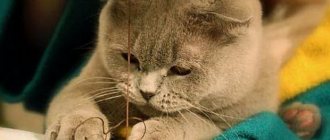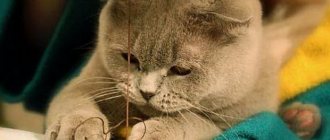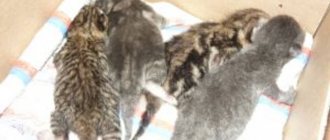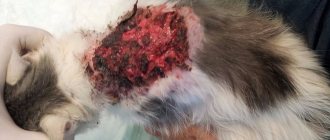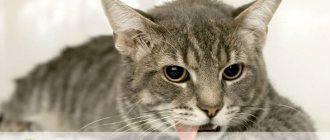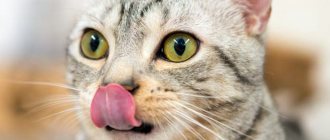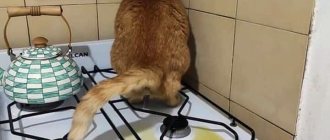A change in gait due to impaired function of the limbs - lameness - is not an independent disease, but a symptom, most often a sign that the animal is in pain. Cats are very active animals, and the sight of a domestic cat limping on a front or back leg often does not cause concern to the owner. However, the causes of lameness are not always harmless, so the owner should know why it can develop and what measures are necessary to eliminate it.
Lameness due to injury
By injuries we do not necessarily mean sprains, fractures or dislocations. It could be a simple wound on the pad of the paw. Pain causes the cat to spare its paw.
If there are no visible injuries, check the cat's reaction by feeling its entire paw: carefully and gently, but with pressure. Perhaps it is a matter of deep trauma. If your cat reacts painfully to touch in a particular place, you should go to the veterinarian. He will take an x-ray to find out the cause. Moreover, sometimes wounds are observed not because of splinters, insect bites and injuries, but because of the disease described below. This disease is dangerous, and therefore an accurate diagnosis must be made as early as possible.
Diseases of the joints and bones
Diseases that affect a cat's joints are often age-related and occur after 6-8 years of life. Some pathologies are congenital and develop gradually; more than a month may pass before the first symptoms appear. Viral diseases and various infections often serve as the impetus for the development of inflammation of joint tissues. If a cat has lameness, the following diseases are possible:
- 1. Hip dysplasia. A genetic abnormality that an animal suffers from birth or has a predisposition to develop. It progresses even at a young age. Lameness in an animal is most noticeable after sleep or rest. When a pet “develops” its limbs after a long period of rest, the symptom is not very pronounced or becomes almost invisible.
- 2. Arthritis and arthrosis. These diseases in most cases occur in older cats and are the most common pathologies affecting the joints. Changes in tissues in both diseases are largely similar, as are the symptoms of their manifestation. The animal tries to move as little as possible - this way the pain practically goes away. The cat refuses to eat and becomes weaker, and sometimes there is a rise in body temperature. Swelling occurs in the joint area, the animal reacts aggressively to palpation, and a local increase in body temperature is felt.
- 3. Patella or luxation of the kneecap. The pathology is rare and is caused by genetic abnormalities or severe trauma. The disease manifests itself abruptly: the animal suddenly begins to limp, it experiences severe pain, to which the cat reacts by meowing and hissing. Treatment is required as soon as possible, since with further development of the disease, surgical intervention will become necessary.
- 4. Osteomyelitis. The disease most often occurs in cats at a young age during the period of active growth. It is characterized by the process of degeneration of bone tissue and its partial destruction, affecting both one limb and several at once. The disease causes severe pain, so the pet does not allow the affected paws to be touched.
- 5. Osteochondrosis. A disease of the spine, as a result of which the spinal roots are pinched or pinched, causing the cat to lame in various limbs. A failure in the formation of cartilage tissue leads to the abrasion of the cartilage layer between the vertebrae, which causes severe pain when moving. A cat sometimes not only limps on its hind leg, but also pulls it back.
- 6. Osteosarcoma. A malignant formation that occurs in bone tissue. Most often it affects animals over the age of 6 years.
All these diseases are serious and require timely treatment under the supervision of a specialist. Typically therapy consists of painkillers and corticosteroids. In severe cases, surgery is required. If you suspect that your cat is limping due to any of the listed joint diseases, you should immediately contact a veterinary clinic. At home, you can only waste time without proper treatment.
Lameness due to osteochondrodysplasia
In the case of lameness of a Scottish fold cat, the possibility of osteochondrodysplasia cannot be excluded. This disease is associated with changes in the structure of the musculoskeletal system and affects fold-eared cats. Read more about this disease in another article. Here we will say that the disease is incurable and can significantly ruin the pet’s quality of life, so a symptom such as lameness cannot be ignored. You need to go to the vet and get a diagnosis. The sooner therapy begins, the greater the chances for a fulfilling lifestyle.
Adjuvant therapy
If a sick cat suffers from obesity, he must be put on a diet (approved by a veterinarian, of course). This is especially important for older animals.
Important! There is no need to completely deprive your pet of food, as this will lead to exactly the opposite results.
Specially designed “joint” diets are recommended. Their components contain combinations of essential fatty acids (EFAs), which serve to reduce inflammation and glycosaminoglycans (such as glucosamine and chondroitin). The latter are part of cartilage. Supplements of this type are completely safe for the animal. The problem is that veterinary practitioners are very leery of oral supplements.
In any case, they are not used as the main therapy: diet is used only as an additional therapeutic technique. In general, the use of agents injected directly into the joint is recommended.
I would like to note that in the most severe and advanced cases of joint disease in cats, they are treated using synthetic prostheses. If the joint has undergone degenerative changes, only implants can restore mobility and maintain a more or less high quality of life for the animal.
Treatment of lameness in cats
Treatment for lameness in cats depends on the cause. Depending on this, either only painkillers, or courses of antibiotics, or anti-inflammatory drugs, etc. will be prescribed. In some situations, complete healing is impossible, but the cat's condition can be maintained at the proper level. In any case, we recommend that you do not treat yourself, but go to a veterinary clinic. If your pet is given a bad diagnosis, you need to recheck it in another clinic, without initially saying that you already know the opinion of another doctor.
Rate and share!
Reasons why a cat is limping
There are many reasons why a cat does not step on its hind paw, as well as its front paw. Often the owner can immediately understand what happened, but there are also situations when an adult pet or kitten simply returns from a walk, limping heavily and mewing pitifully. In this case, the first thing to do is to carefully examine the paw, which the animal cannot stand on normally.
The following reasons may cause the problem:
:
- Stinging insect bite - the bites of wasps and bees are painful, and therefore, if a cat steps on an insect, he is guaranteed lameness for 2-4 days, even after the owner removes the bee sting or treats the wasp sting. The left or right limb may be affected. If the bite occurred 7-9 days ago and the cat is still limping, a visit to the veterinarian is required;
- Injury to the interarticular area - often occurs during a fight between cats if teeth are used; and also during active climbing on trees that have sharp thorns or twigs. If a cat is not careful, or gets too carried away with tracking birds, it can run into them. The injury most often affects the hind legs, since the animal usually still sees the place where the front paw is placed;
- Dislocation - occurs when unsuccessful jumps and falls cause unnatural movement of the head of the bone in the joint, causing it to come out of it. The paw completely loses mobility and hangs helplessly. Acute pain at the time of injury can cause the animal to go into shock. In this case, the cat may limp on its right or left hind leg. Even with treatment, the cat limps for a long time;
- A sprain is the most common limb injury in cats, in which a minor tear of part of the fibers of the ligaments occurs, causing pain and swelling in the paw. The cat limps quite heavily, but his general condition does not suffer. The animal remains cheerful and does not lose its appetite. Lameness usually goes away within a few days even without treatment. In case of severe sprain, to speed up the recovery of the ligaments, a course of therapy with the drug travmatin, which is administered in the form of injections, is indicated. The animal limps long and hard;
- A bruise is of a traumatic nature. If the injury is not severe, then the cat limps slightly and not for long. With a severe bruise, the cat falls seriously on its back paw, which looks swollen. The pet is limping in such a way that it cannot be ignored. If you move the fur apart, a pronounced hematoma will be clearly visible;
- A fracture is the most severe injury in which the integrity of the bone is disrupted. The cat is not only limping, but almost unable to stand on his paw. Occurs when a strong blow or paw is pinched. In rare cases, physiological fractures are possible, which occur due to the fact that the bones lose their natural strength. Such fractures occur even with minor impact on the bone. The cat is limping and cannot stand on its paw;
- Spinal injury in the lumbar region - with such damage, a disturbance in the transmission of nerve impulses occurs, due to which the movement of the hind legs is difficult and limited. In severe cases, complete paralysis of the hind limbs occurs. In case of injury without paralysis, lameness is observed immediately on 2 hind legs and can be very specific;
- Arthritis or arthrosis of the hip joint - the disease can be unilateral or bilateral. The animal limps in front of him, also wobbling its pelvis. It occurs most often in older cats, but can also affect young animals if they have suffered serious trauma to the pelvic area. With this phenomenon, lameness increases gradually, worsening the cat’s quality of life. Treatment is aimed primarily at slowing the progression of the pathological process. A complete cure is impossible.
The owner will not always be able to pinpoint the exact reason that caused the lameness, and therefore a consultation with a veterinarian may be required.
Content Features
In general, these cats are not picky. It is advisable for the pet to have a cozy place where he can hide and remain in privacy.
It is also important to take care of a scratching post, toys, and a proper diet, since this breed is prone to obesity.
Your pet should be brushed a couple of times a week. To prevent dental problems, brush your cat's teeth. Pay special attention to cleaning your pet's ears.
The Scots are considered to be neat people, so owners should carefully and regularly wash their bowls and also clean the tray. An extra bowl or glass for water should be placed away from food, so your cat will drink better.

